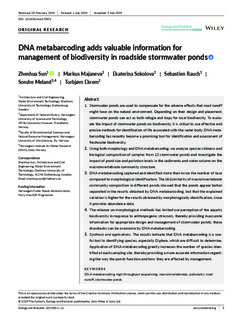| dc.contributor.author | Sun, Zhenhua | |
| dc.contributor.author | Majaneva, Markus | |
| dc.contributor.author | Sokolova, Ekaterina | |
| dc.contributor.author | Rauch, Sébastien | |
| dc.contributor.author | Meland, Sondre | |
| dc.contributor.author | Ekrem, Torbjørn | |
| dc.date.accessioned | 2019-08-08T10:44:58Z | |
| dc.date.available | 2019-08-08T10:44:58Z | |
| dc.date.created | 2019-08-07T10:34:30Z | |
| dc.date.issued | 2019 | |
| dc.identifier.citation | Ecology and Evolution. 2019, . | nb_NO |
| dc.identifier.issn | 2045-7758 | |
| dc.identifier.uri | http://hdl.handle.net/11250/2607578 | |
| dc.description.abstract | Stormwater ponds are used to compensate for the adverse effects that road runoff might have on the natural environment. Depending on their design and placement, stormwater ponds can act as both refugia and traps for local biodiversity. To evaluate the impact of stormwater ponds on biodiversity, it is critical to use effective and precise methods for identification of life associated with the water body. DNA metabarcoding has recently become a promising tool for identification and assessment of freshwater biodiversity. Using both morphology and DNA metabarcoding, we analyze species richness and biological composition of samples from 12 stormwater ponds and investigate the impact of pond size and pollution levels in the sediments and water column on the macroinvertebrate community structure. DNA metabarcoding captured and identified more than twice the number of taxa compared to morphological identification. The (dis)similarity of macroinvertebrate community composition in different ponds showed that the ponds appear better separated in the results obtained by DNA metabarcoding, but that the explained variation is higher for the results obtained by morphologically identification, since it provides abundance data. The reliance on morphological methods has limited our perception of the aquatic biodiversity in response to anthropogenic stressors, thereby providing inaccurate information for appropriate design and management of stormwater ponds; these drawbacks can be overcome by DNA metabarcoding. Synthesis and applications. The results indicate that DNA metabarcoding is a useful tool in identifying species, especially Diptera, which are difficult to determine. Application of DNA metabarcoding greatly increases the number of species identified at each sampling site, thereby providing a more accurate information regarding the way the ponds function and how they are affected by management. | nb_NO |
| dc.language.iso | eng | nb_NO |
| dc.publisher | Wiley | nb_NO |
| dc.relation.uri | https://onlinelibrary.wiley.com/doi/10.1002/ece3.5503 | |
| dc.rights | Navngivelse 4.0 Internasjonal | * |
| dc.rights.uri | http://creativecommons.org/licenses/by/4.0/deed.no | * |
| dc.title | DNA metabarcoding adds valuable information for management of biodiversity in roadside stormwater ponds | nb_NO |
| dc.type | Journal article | nb_NO |
| dc.type | Peer reviewed | nb_NO |
| dc.description.version | publishedVersion | nb_NO |
| dc.source.pagenumber | 11 | nb_NO |
| dc.source.journal | Ecology and Evolution | nb_NO |
| dc.identifier.doi | 10.1002/ece3.5503 | |
| dc.identifier.cristin | 1714510 | |
| dc.description.localcode | This is an open access article under the terms of the Creative Commons Attribution License, which permits use, distribution and reproduction in any medium, provided the original work is properly cited. © 2019 The Authors. | nb_NO |
| cristin.unitcode | 194,31,10,0 | |
| cristin.unitname | Institutt for naturhistorie | |
| cristin.ispublished | true | |
| cristin.fulltext | original | |
| cristin.qualitycode | 1 | |

